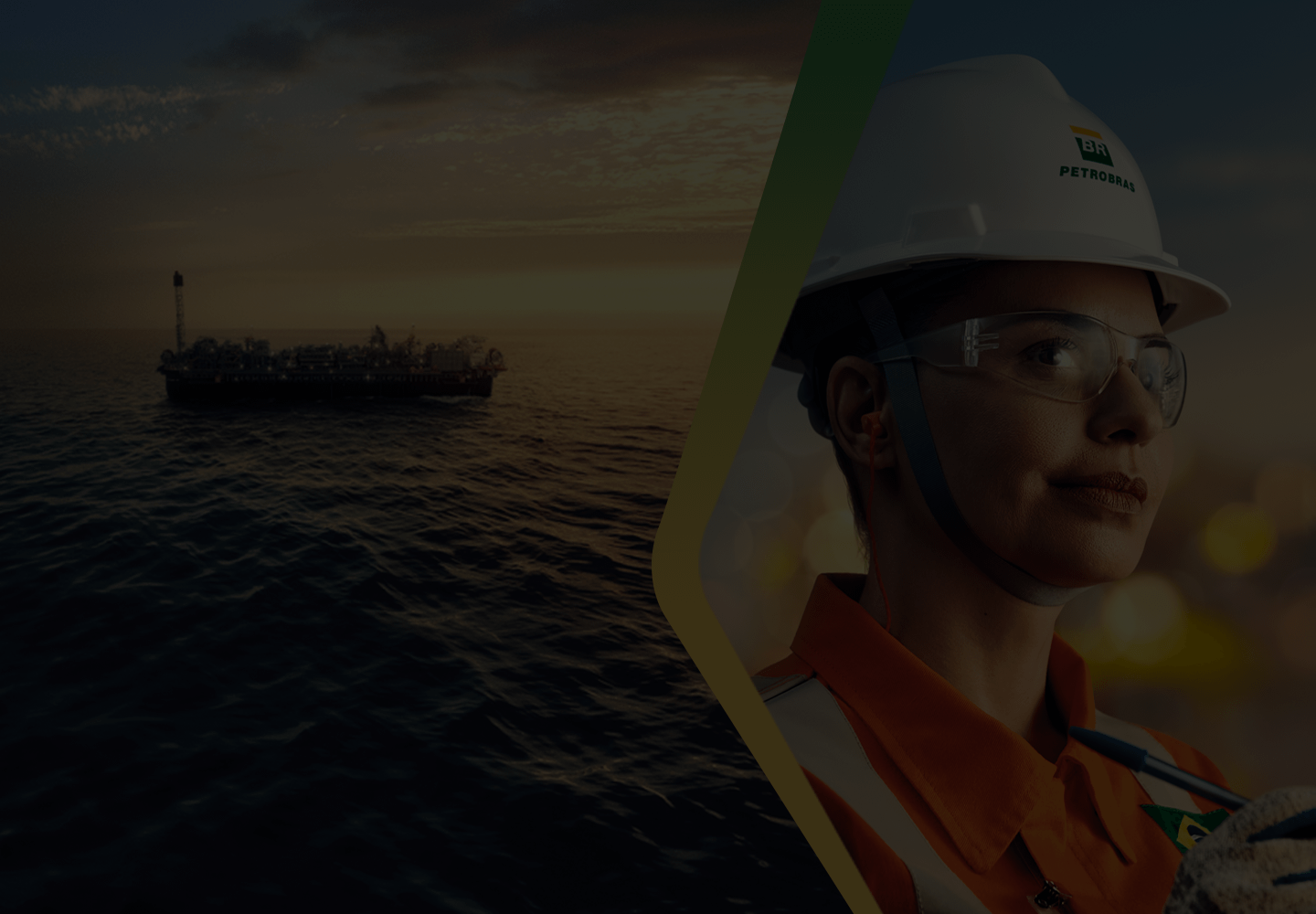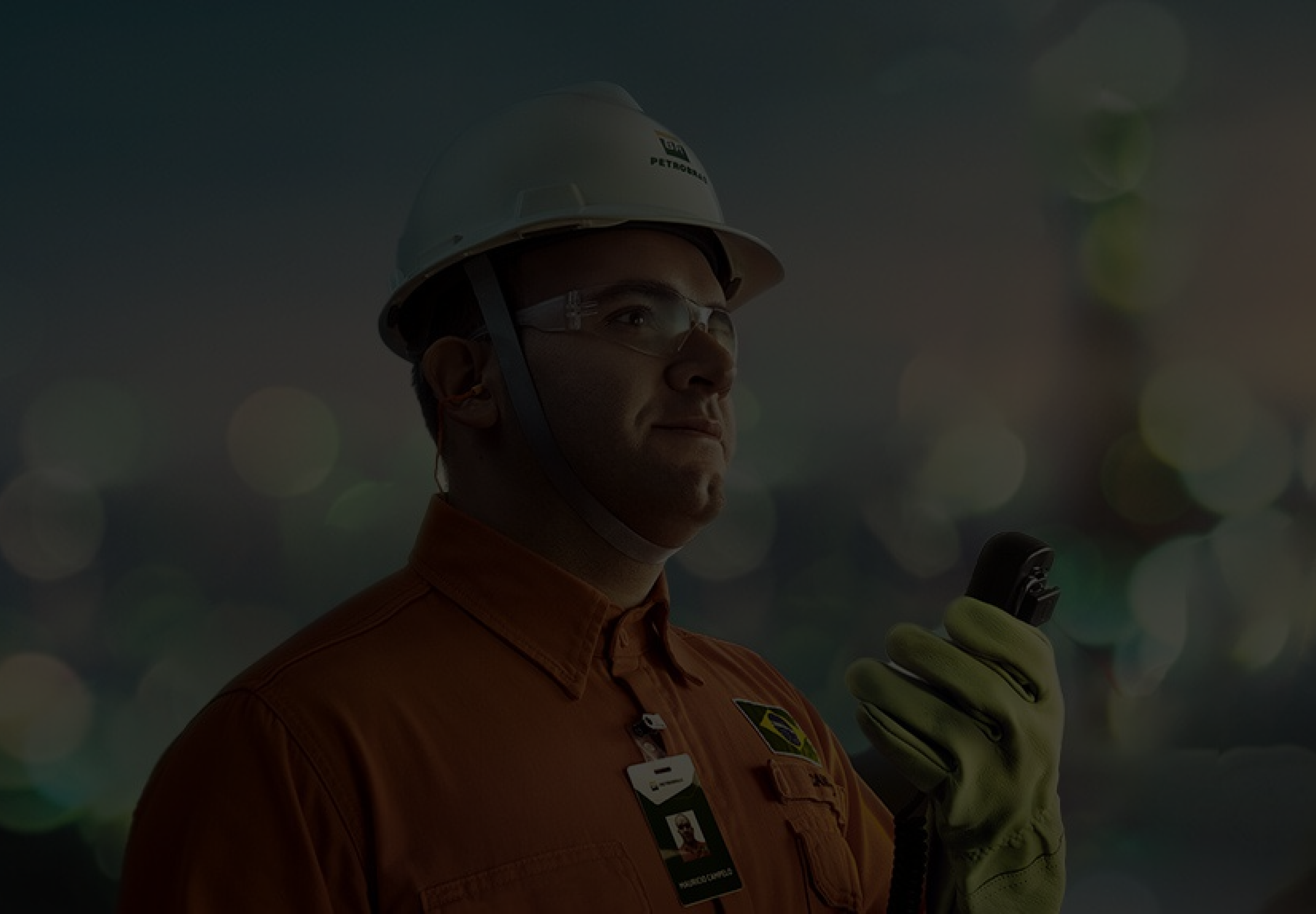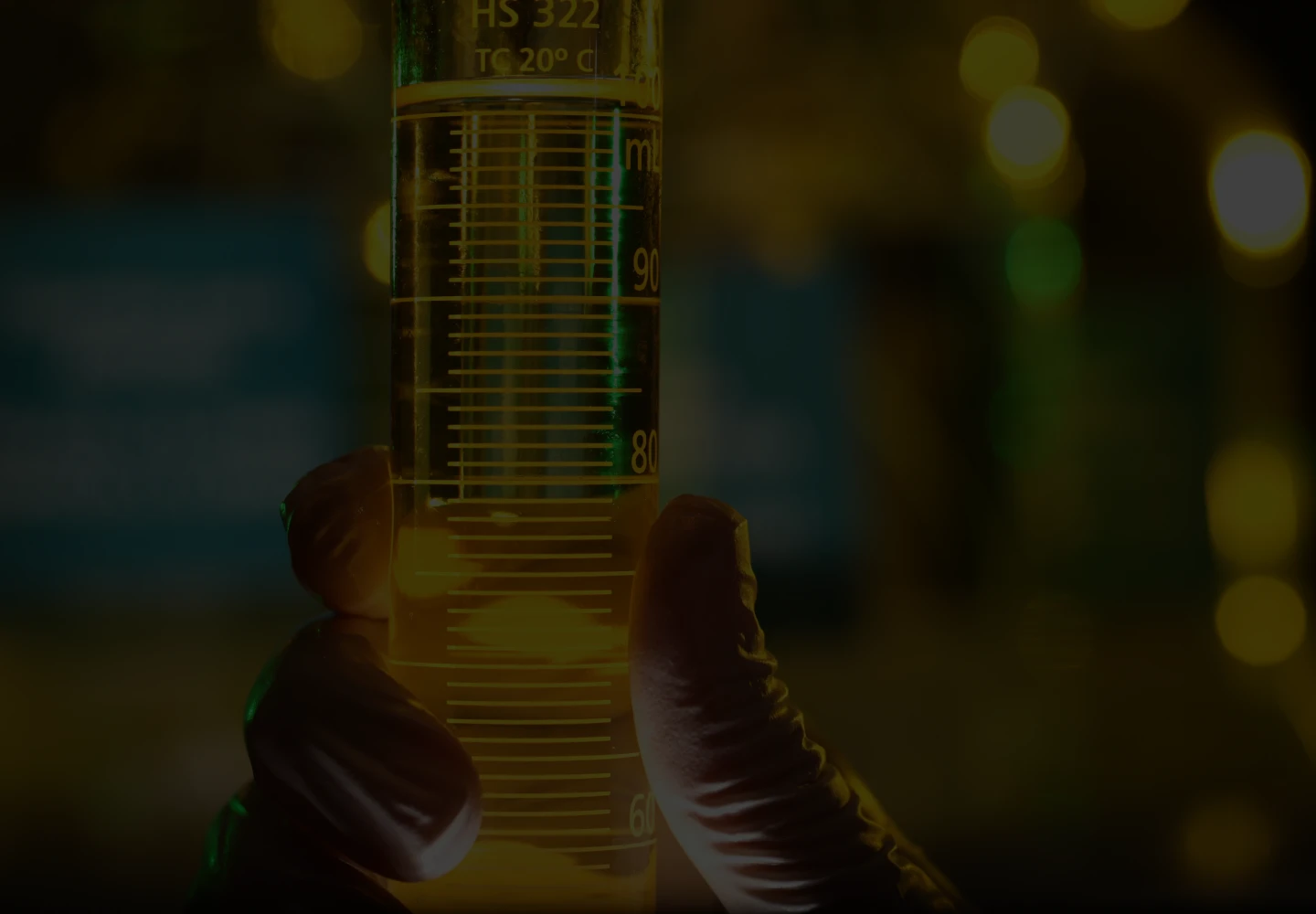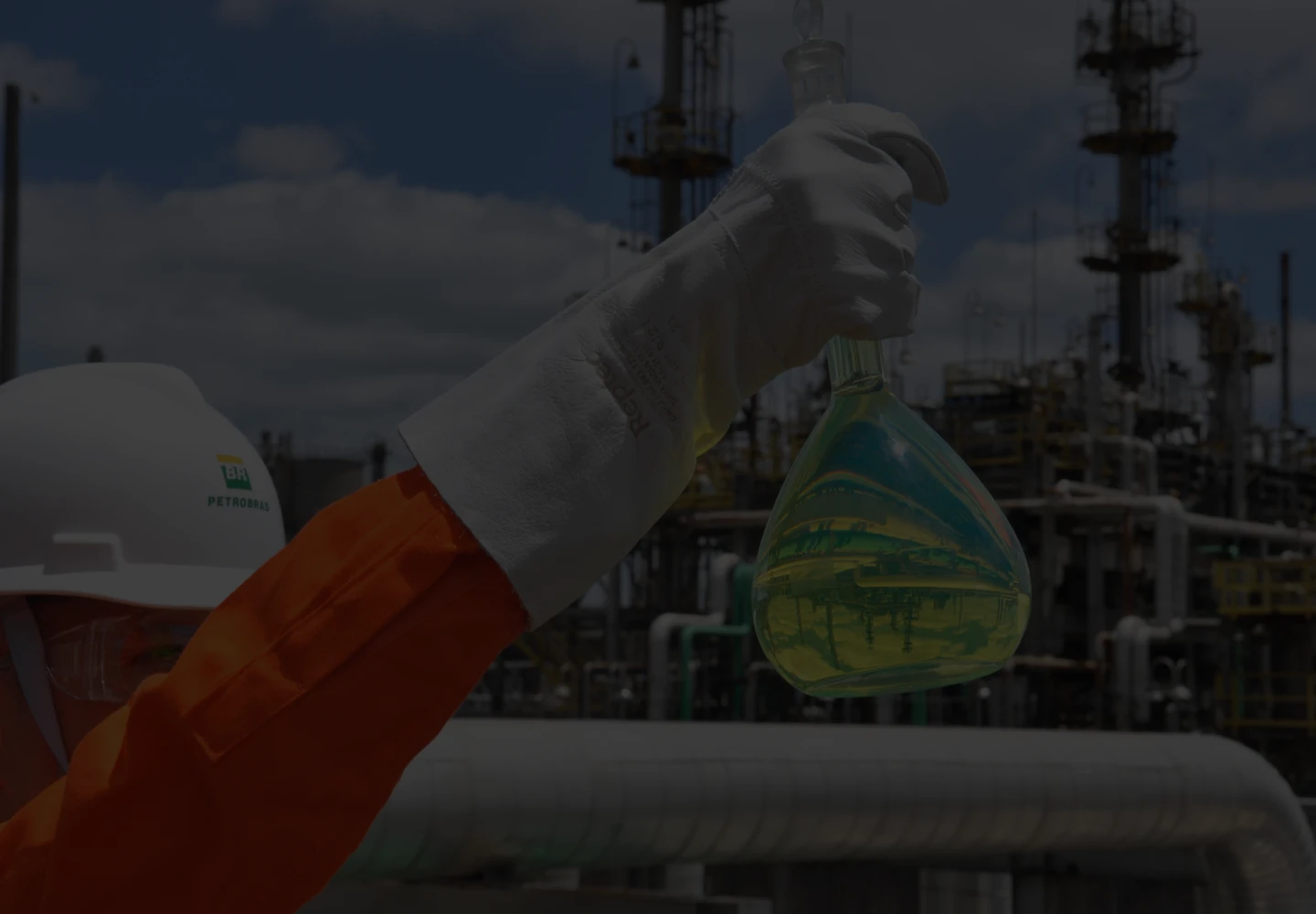Trajectory
2024

Learn about our history and evolution throughout the years
In 1953, we began our journey aiming to transform Brazil's energy sector. Since then, we have innovated, grown and diversified our operations. Now, we are using our expertise to overcome new challenges and lead a new journey: a fair, inclusive and safe energy transition for all Brazilians. Find out more about our history.

We received the Distinguished Achievement Award from the Offshore Technology Conference (OTC) for the 5th time
Our fifth award is a merit of the Campos Basin Renewal Program responsible for driving technological innovations in wells, underwater equipment and surface systems in our operations in the Campos Basin. The program brings results such as fewer emissions, reduced costs and safer operations, which reflect our commitment to bringing energy in a sustainable and fair way to everyone.
2023

We celebrate our 70 years of history
Since our foundation, we have trailed a path of leadership and we have been pioneers in directing our energy to everything that matters to Brazil. An energy that is present in every corner of Brazil, in the daily life of Brazilian citizens.

Award-winning carbon reinjection technology
We have received an unprecedented acknowledgement granted by global company “Carbon Sequestration Leadership Forum” (CSLF), for our contribution to the development of CO2 capture and storage technology (CCUS).
It is the first time that a company in Latin America receives the award, which emphasized the relevance of the CCUS project to the global industry and its demonstration of safety in the geological storage.
2022

Hisep: patented technology to reinject CO2
With Hisep (High Pressure Separation), natural gas with CO2 does not require transportation up to the platform drillship. Thus, the technology reduces energy expenses and the space to store and process inputs in these units.

Our Pegasus supercomputer is the biggest one in Latin America, regarding processing capacity
The supercomputer is also the more eco-efficient. Our high-performance computer leadership allows us to apply technical knowledge in the geophysical and geological data processing to reduce uncertainties and project risks, just as the time between a new discovery of an oil field and the start of production.
2021

Búzios Field wins our fourth OTC award
Distinguished Achievement Award for Companies 2021, granted by OTC, was the result of our set of innovations prepared to enable the production of Búzios - the largest oil field in deep waters of the world - in the pre-salt layer of the Santos Basin.
2018

Oil and Gas Climate Initiative (OGCI)
We shall integrate the Oil and Gas Climate Initiative (OGCI), an organization formed by presidents of the ten major global operators of oil and gas. OGCI has the objective of increasing the scope, speed and scale of actions carried out by the companies individually to reduce the greenhouse gas emissions in its oil and gas activities.

Ten years of production in pre-salt layer
We have completed 10 years of production in the pre-salt layer and reached the figure of 1.5 million oil barrels produced per day. From the first oil extracted in the pre-salt layer, in September 2008, until this expressive figure, we have taken a giant leap in our production and our results.
2017

We have increased the safety in our operations
In order to improve our processes in relation to safety, we have worked both in preventative and reinforcement actions regarding the treatment of deviations and incidents. Among important initiatives to reach these goals and that reinforce the safety of our operations, we provide different training sessions for our workforce.
This year, we have exceeded our top metrics for Recordable Accident Rate (TAR), anticipating the satisfaction of this indicator regarding our planning.

AAPG Distinguished Service Award
We have been recognized by the American Association of Petroleum Geologists (AAPG) for our leadership and dedication in the development and disclosure of knowledge on oil geology. The award is one of the most important in the world for the segment and has been granted to our geologist Sylvia Anjos, who became the first Brazilian woman to receive it.
2016

Production in the pre-salt layer reaches 1 million barrels of oil per day
The oil production in the Brazilian pre-salt layer has exceeded the mark of 1 million barrels per day.
2015

Our pre-salt production wins another OTC Award
For the third time, we have won the biggest global award for the segment. This time, we have been recognized for the high-end technologies developed for exploration and production in the pre-salt layer, seven years after its discovery. In the same year, our pre-salt production reached 300 thousand barrels of oil per day.
2014

New structure of the Governance, Risk and Compliance Executive Office
We continue to improve the control and anti-corruption mechanisms in the company. In 2014, a new structure was created for the Governance, Risk and Compliance Executive Office, which incorporated and assembled the structures and activities that were already carried out by other areas, such as Comptrollership and Corporate Management of Business Risks.
For the following year, the structure also created a new Reporting Channel, in which the receiving reports was assigned to a specialized and independent company.
2011

Capitalization of Petrobras
With the objective of raising more funds to invest in the pre-salt layer, without increasing indebtedness, we have made the largest capitalization in the world. We have offered shares to the market in the amount of USD 70 billion.
2008

Start of production in the pre-salt layer
The exploration and production of oil & gas on the Brazilian shore has opened up a new horizon for the oil industry worldwide. In addition, it has also driven us to create a series of strategic actions to guarantee development and bring technology, professional training and big opportunities to the national industry.

Creation of Petrobras Biocombustível
This subsidiary is responsible for the development of ethanol and biodiesel production and management projects.
2007

The pre-salt layer discovery
The discovery of oil & gas in the pre-salt layer of the Brazilian shore has opened up a new horizon for the oil industry worldwide. At the same time, we have created a series of strategic actions that ensure the development of the entire goods and service chain, bringing technology, professional training and big opportunities to the national industry.
2006

Dow Jones Sustainability Index
For the first time, we were part of the Dow Jones Sustainability Index (DJSI), which gathers companies with significant social, economic and environmental responsibility in the United States stock exchange. In the following years, this achievement was attained many times.

Development of H-Bio
Cenpes and universities have developed an innovative refining process that uses an amount of vegetable oil in the production of conventional diesel.

We have reached self-sufficiency
We have celebrated sustainable self-sufficiency in Brazil for oil and gas production with the operation of the P-34 and P-50 platforms, which projects were developed by Cenpes. With average daily production of 1.9 million barrels per day, the country started exporting more oil and byproducts than importing them.
2005

Diversity and focus on people
We have been a part of the Gender and Race Pro-Equity Program since its first edition in 2005. The participation of Petrobras in the Gender and Race Pro-Equity Program emphasizes the commitment of the company with diversity issues, in line with its strategic position to be a socially responsible company.
A series of achievements was incorporated over time, with participation in this program, such as: adoption of paternity leave of ten consecutive days, extension of benefits and reimbursement of daycare assistance for male employees, expansion of maternity leave to over 180 days in the case of premature children, among others.

We were elected the Dream Company for Young People in Brazil for the first time
In 2005, Petrobras broke a series of victories by multinational companies and was first place. The possibility of professional development and accomplishment, the good image of the company in the market, the salaries and benefits were mentioned as more important factors for such choice. This survey was coordinated by the Cia de Talentos company.
2004

Renewable energies
Our first wind park was installed in a pilot scale, in a production field in the city of Macau, Rio Grande do Norte. The park is made up of three air generators with 600 kW of power each, producing a total of 1.8MW of power, energy that is sufficient to supply a city with 10 thousand residents.
The air generators of Macau were installed to supply two electrical generators and a mechanical diesel oil pump, which expelled a large amount of CO2 into the atmosphere.
2003

Global Compact
We became signatures of the UN Global Compact. Thus, we have undertook the voluntary commitment - which we maintain until this date - of complying with and informing our progress regarding the ten principles of this initiative, related to human rights, the environment, labor relations and anti-corruption.

Launch of the Petrobras Environmental Program
Since the 1980s, Petrobras has sponsored several environmental projects, such as: Tamar Project, Humpback Whale, Spinner Dolphin Project, Marapendi Project, among others. With the launch of the Petrobras Environmental Program, new areas chosen by the public were incorporated (Preservation and Memory; Production, Diffusion and Reflection) and all of them were assembled for the first time in a single program.
2002

Podium Gas: high technology
The Petrobras Podium gas is launched on gas stations. Its exclusive formula and special additives, developed for high-performance engines, ensure an even more efficient and cleaner fuel, with higher octane rating and reduced Sulphur content.

Creation of the General Ombudsman
On May 2, 2002, our General Ombudsman was created. At the time, it wasn’t a formal body, but it already performed the important role of independent channel for relations with our stakeholders. In 2005, it started being directly linked to the Board of Directors and became the unit responsible for the company’s reporting channel.
2001

Once again recognized by the OTC Award
The progress in technology and economy of projects in deep waters for the Roncador field, the Campos Basin, have rendered us a second OTC Award for Distinguished Achievement Award for Companies, Organizations, and Institutions, which is considered the biggest world recognition for the oil industry.

The search for excellence in Health, Safety and the Environment (HSE)
The Program for Excellence in Environmental Management and Operational Safety - Pegaso - was created to carry out studies for environmental impact and developing techniques for preventing accidents and immediate rescue in the oil industry.
Pegaso consisted in the development of environmental characterization techniques and techniques for the treatment of contaminated soil and water, as part of the program for excellence in environmental management and operational safety.
1994

The resumption of national cinema
“Carlota Joaquina, Princess of Brazil” and “O Quatrilho”, Oscar nominated, were the first film productions that we sponsored and marked the resumption of Brazilian cinema. Throughout over 20 years of partnership with the Brazilian audiovisual industry, Petrobras has sponsored over one thousand cinematographic works.
1993

Cenpes Innovations
Development of new 2D and 3D techniques that enable a better identification oil production areas.
1992

New world recognition
We have won the OTC Distinguished Achievement Award, the most important award in technology granted at the Offshore Technology Conference, in Houston, United States, as the company that contributed the most to technological development in the offshore industry.
1987

Creation of Proamb
The Technological Environment Program - Proamb, was created with the objective of developing and perfecting technologies for the processes, products and services of the Petrobras system to contribute to the preservation of the environment.
Within the scope of this program, Cenpes created two laboratories to analyze gases of light engines (automobiles) and heavy engines (trucks) and a combustion laboratory, to measure emissions from chimneys, study alternative fuels and perfect burners and other devices.
1986

Creation of the Petrobras Pró-Música Orchestra, currently the Petrobras Symphonic Orchestra
This is the oldest sponsorship maintained by a company to a single orchestra in Latin America.

Petrobras in the Amazon
The Urucu Field goes into operation, located in the Solimões River Basin.
1985

Pioneers in deep waters - Procap
With the need to develop technologies to operate in deep waters, the Technological Training in Deep Waters Program (Procap) was created. It was an extremely ambitious program as, at the time, we explored oil at a 150 meters range and already had plans for one thousand meters.
But the great piece of news of this strategic plan was the option to incentivize all aspects of oil research in deep waters. After the discovery of the giant fields of Albacora and Marlim, in the Campos Basin, a challenge arose: producing oil in a water table exceeding 600m and, to do this, there was no proven commercial technology. As a result of this challenge, Procap was created.
1976

Launch of LUBRAX lubricants
Launch of the LUBRAX line in the national market, with over one hundred products with several applications in the automotive area, in the industry, in aviation and in railway and maritime sectors.
1975

The beginning and future of Biofuels
Due to oil crisis, the National Ethanol Program or “Pró-Álcool” was created. The goal was to reduce the country’s reliance on imported oil by replacing gas with ethanol, produced from sugarcane, cassava and other inputs. The Program managed to reduce in 10 million, the number of automotives consuming gas in Brazil. In December 1977, the prototype unit for manufacturing ethene from ethanol, Reduc, started its operations as designed by Cenpes.
1974

Operations abroad - Braspetro
At the same time, we have moved on to offshore exploration, the international oil crisis led us to seek new partners abroad. We have created Petrobras Internacional - Braspetro, a subsidiary dedicated to activities in the areas of oil exploration and production, trading, and export of Brazilian products (which would later become part of Interbras). New contracts are executed for exploration in Algeria and Libya.

The discovery of the Campos Basin
The Organization of the Petroleum Exporting Countries (OPEC) significantly increased international prices, causing an “oil shock”. The crisis in the global market defined the entire 1970s.
In order to suppress supply in the country, we sought oil at sea. Our efforts culminated in the discovery of the Campos Basin - located between the North shore of the state of Rio de Janeiro and the South of Espírito. It has become the largest oil province in Brazil, responsible for more than 80% of national oil production.
1968

Oil at sea and the first platform
P-I was built as a mobile drilling platform and was capable of operating in waters up to 30 meters deep. It was this platform that discovered the Guaricema field, the first oil field on the Brazilian continental shelf, in the sea of Sergipe.
1967

Creation of Petrobras Química S.A. (Petroquisa)
The subsidiary was founded to articulate the action of the state and private sectors in the implementation and development of the Brazilian petrochemical park.
1963

Cenpes is born, our research center
Our Research and Development Center was created to meet the technological demands essential to our consolidation and expansion. At first, Cenpes was spread over several points in Rio de Janeiro. In 1972, the transfer to Fundão Island began, which lasted until September 1973.
1961

Construction of the first refinery
We founded our first refinery, Reduc (Duque de Caxias Refinery), in the state of Rio de Janeiro. Thanks to it, that same year, we achieved self-sufficiency in the production of the main byproducts. Even today, Reduc is the most complete refinery in our system.
1958

First logo
Designer Luiz Pepe created our first logo. Before Petrobras, Pepe was a cartographer for the National Petroleum Board (CNP). His design related our brand to the colors and shapes of the national flag, a reflection of nationalism at the time.
1955

Creation of the Petroleum Improvement and Research Center - Cenap
The agency had the objective of training specialists and developing research in the area of oil exploration. In 1966, it was divided into the Teaching Division (DIVEN), and the Research and Development Center (CENPES), aimed at technological research.
1954

The Petrobras installation is concluded
Once the implementation was completed and with the start of operations, the following refineries were incorporated into our company's assets: Mataripe, built in 1949, in São Francisco do Conde (BA); the Presidente Bernardes Refinery, designed in 1952 and inaugurated in 1955, in Cubatão (SP); and the National Oil Tanker Fleet.
1953
The beginning
Motivated by the "Oil is ours" campaign, President Getulio Vargas signed Law No. 2,004, which created Petrobras. Fully nationally controlled and owned, with a majority interest of the Federal Government, Petrobras has a monopoly on the exploration of all stages of the oil industry, with the exception of distribution.
2024
2023
2022
2021
2018
2017
2016
2015
2014
2011
2008
2007
2006
2005
2004
2003
2002
2001
1994
1993
1992
1987
1986
1985
1976
1975
1974
1968
1967
1963
1961
1958
1955
1954
1953
You may be interested in

Do a search:
Language:
Select a language:
Accessibility
Choose a channel:








